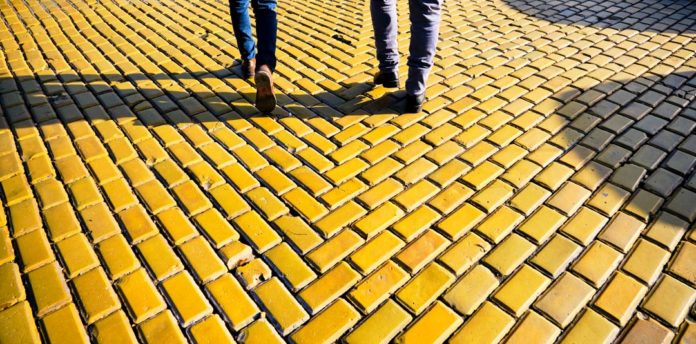A Golden Welcome: A Walk Like No Other
Suppose you’ve ever taken a stroll through central Sofia and found yourself wobbling awkwardly while admiring the neoclassical architecture. In that case, you’ve likely walked on the famous жълтите павета — the yellow cobblestones that pave Bulgaria’s most historic streets. They don’t just offer a path — they whisper stories from the past with every uneven step.
Worn smooth by parades, protests, and decades of foot traffic, the yellow bricks aren’t just pavement — they’re a cultural monument. But where did they come from, and why are they so special?
An Austro-Hungarian Gift Fit for a Prince
The story of Sofia’s yellow cobblestones begins with a prince and a vision.
In the early 1900s, Knyaz Ferdinand I of Bulgaria was on a mission to modernize Sofia. Once an Ottoman provincial town, Sofia had become the new capital of an independent Bulgaria in 1879, and Ferdinand wanted to turn it into a “little Vienna.” Inspired by European capitals, he ordered a new royal palace, elegant boulevards, and yes — imported golden cobblestones.
But these weren’t just any stones. They came from Kuttelburg (now Lučenec) in what was then part of the Austro-Hungarian Empire, today Slovakia. The region was famous for its clay-based ceramics and distinctive yellow-hued paving bricks, made from high-quality kaolin clay and baked at extremely high temperatures for durability.
Between 1907 and 1908, under the reign of Ferdinand, thousands of these bricks were shipped by train to Sofia — a royal gift from Emperor Franz Joseph I himself, honoring the strengthening ties between Bulgaria and the Empire.
They were first laid on Tsar Osvoboditel Boulevard and gradually expanded across Dondukov Boulevard, the area around the former Royal Palace, and what is today the National Assembly Square.
Why Yellow? A Symbol of Power and Prestige
Yellow wasn’t just a color — it was a statement.
Unlike dark, dull cobblestones, these golden bricks shimmered in the sunlight. They were associated with wealth, royalty, and European elegance. Yellow bricks were used in only a few other cities in Europe (like Vienna, Budapest, Bratislava, Prague, Zagreb, and Lviv), making Sofia’s cobblestones one of the rarest — and most charming — relics of Belle Époque urban planning.
For Bulgarians, they symbolized a transition from the dusty backstreets of the Ottoman era to a modern, independent European identity.
Cracked Legacy: Why They’re So Hard to Replace
Fast forward over 100 years, and Sofia’s yellow cobbles are still in place — but not without their quirks.
Why do they wobble so much? The original bricks were never designed for modern traffic. With the rise of cars, buses, and even tanks (Sofia saw its share of military marches), the ground beneath began to shift. The bricks are brittle, porous, and challenging to realign once removed.
Can’t we make more? Not really. The original kaolin-rich clay no longer comes from the same source. Modern attempts to reproduce the exact texture and color have mostly failed. A 2022 trial to replicate the bricks using domestic materials proved too costly and color-inaccurate.
Why are they always being repaired? Between 2017 and 2023, Sofia underwent several restoration efforts around the Largo and Parliament. But each time the bricks were lifted and reset, complaints followed: misaligned patterns, uneven surfaces, and cracking. In 2024, a portion of Dondukov Blvd. had to be redone again — for the third time in seven years — after heavy rains exposed poor workmanship.
The city now relies on a small stockpile of salvaged original bricks, carefully stored by the municipality.
Fun & Curious Facts for the Inquisitive Tourist
- The yellow bricks cover approximately 22,000 square meters in Sofia’s city center.
- One of the last remaining original bricks was stolen in 2019 and later found listed for sale online.
- Rumor has it that Winston Churchill once called them “the only yellow road that leads somewhere real” during a wartime diplomatic comment.
- The surface temperature of the bricks can reach over 60°C in summer, making them some of the hottest surfaces in the city.
- The sound of horse hooves on the bricks — a rare delight today — is considered by locals to be one of the most nostalgic sounds of Sofia.
How to Enjoy Them Today
For the best experience, start your walk at Alexander Nevsky Cathedral and follow the yellow brick road (yes, that’s what locals call it!) past the National Assembly, Russian Church, and National Art Gallery, all the way to Independence Square.
If you time it right, you’ll catch the golden glow of the setting sun reflecting off the bricks — a photographer’s dream and a memory worth keeping.
Legacy and Future: Preserving the Golden Path
In 2025, the city announced a new conservation strategy, working with international heritage organizations to protect the pavement under UNESCO guidelines. While replacing them entirely is off the table, new technology may allow 3D scanning and digital modeling to improve future repairs.
For now, the bumps and cracks are part of the charm. They slow you down, force you to look around, and remind you — Sofia is not a city you rush through. It’s one you stroll through, stone by stone.



